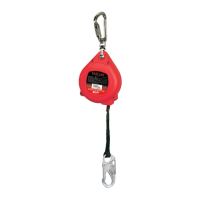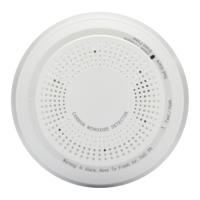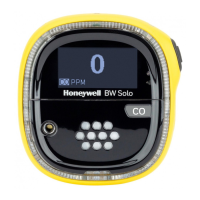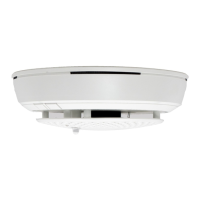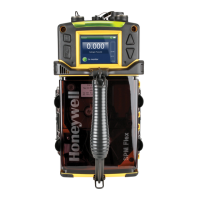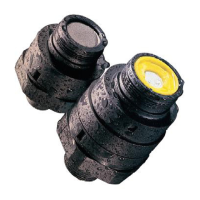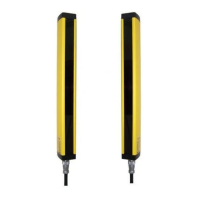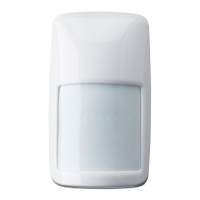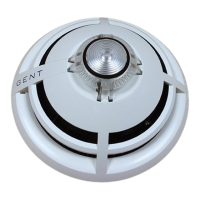4.2.4 J1 Remote Test Settings
13. Attach the detector base on Mounting Plate SC110 and
then use the two M4×8mm screws provided to fix it.
14. Wire and configure the detector (see “4. Wirings and
Settings”), and then use the top screw to fix the
detector cover properly.
Position Function Method Result
1
No test Connect jumper to J1 pin 1 only.
1-2
Electronics test
Connect jumper to J1 pin 1 and 2;
Apply 0 volt to terminal 10 on the terminal
block (see Figure 6) to start the test.
A successful remote test will be
acknowledged by an alarm from
the detector within 1 second.
2-3
Complete test
including mounting
check
Connect Test Transmitter SC113 to J1 (black
cable to pin 2 and red cable to pin 3);
Apply 0 volt to terminal 10 on the terminal
block (see Figure 6) to start the test.
A successful remote test
including mounting check will be
acknowledged by an alarm from
the detector within 1 second.
4. Wirings and Settings
Wirings and settings are configured on detector base. All function modules on the detector base are shown as below.
Figure 5 Detector Base
* Factory default settings are shown in grey.
J1
5. Maintenance
DIP Switches
Noise LED
Check the detector mounting and functions regularly (once a year at least).
Tamper Switch
Note: Connect T
erminal9 to low level (<0.6VDC), the sensitivity of detector will be reduced to about 1/8 of original level.
J19
EOL Jumpers
J20
6. Technical Specifications
Terminal Block
Power Requirements
Supply Voltage 8 ~ 16 VDC, nominal 12 VDC
Current Consumption (quiescent) Typical 3 mA @ 12 VDC
Current Consumption (alarm) Typical 2 mA @ 12 VDC
Voltage Ripple 100Hz, ≤10% of nominal voltage
Step Change Unom +/- 25%
Slow Change of Supply Voltage Unom +/- 25%
Warm-up Time < 5 sec
Sensitivity
Adjustable Sensitivity 4 levels by DIP Switches
Reduced Sensitivity (Maintenance, Service) Input Active low (terminal 9) ≤ 0.6 VDC
Detection Radius (Thermal Tools) on Concrete K350 5 m
Detection Radius (Thermal Tools) on Steel 5 m
Alarm Outputs
Solid State Relay SPDT (Change Over) 30 VDC / 100 mA / typical Ri=25 Ω
Transistor Open Collector Active low during alarm / Ri=1.38 kΩ
Alarm Hold Time Approx. 2.5 sec
Sabotage Protection
Pry-off and Cover Switch 30 VDC / 100 mA
Low Supply Voltage Alarm * < 6.5 VDC
Temperature Alarm * +85°C ± 5°C
Internal Functional Alarm* Stainless steel drill shield
* Sabotage and fault functions will cause the alarm relay to drop.
Inputs
Remote test of detector mounting and detector function or
Remote test of detector electronics only.
Active low ≤ 0.6 VDC, test duration < 1 sec
Reduced Sensitivity (maintenance, service) Input
Active low ≤ 0.6 VDC, duration = as long as active low
Sensitivity reduction to 12.5 %
Installation Tool
A noise and alarm indicator is incorporated to support sensitivity setting.
Environmental Conditions
Maximum Humidity 95% RH (non-condensing)
Operation Temperature -40°C ~ +70°C
Storage Temperature -50°C ~ +70°C
Environmental Class (VdS) III
Housing Protection Category IP43 IK04
Housing
Dimensions (H x W x D) 80 mm x 60 mm x 21 mm
Chassis and Cover Die-cast metal
Color RAL7035 (light grey)
Weight 0.228kg
4.1 Wirings
4.1.1 Terminal Block Wiring
The wirings should be connected to the terminal block first, and then should be connected to the panel.
Figure 6 Terminal Block Wiring
Note: The open collector alarm output
(terminal 8) will be active low during alarm.
4.1.2 Panel Wiring
According to the different terminal block wirings, there are two ways to connect the detector to the panel.
Alarm and tamper configured to one loop Alarm and tamper configured to two loops
RTI RSI S/OC T2 T1 C NC V+NO 0V
Z1
COM
Tamper
RT
Alarm
J20
RA
Connected to a zone configured as Dual-End-of-Line
RTI RSI S/OC T2 T1 C NC V+NO 0V
Ta m pe r
RT
Alarm
J20
Z1 COM
Z2
Connected to a zone configured as Single-End-of-Line
Detec
tor
Detector
Note: W
hen this wiring
diagram is used, RT still
can be used for tamper
loop, but the jumper on
RA needs be removed
and the external EOL
resistor has to be
connected to alarm
loop.
External EOL
Resistor
Pan
el
Panel
4.2 Settings
4.2.1 DIP Switch Settings
ON
OFF
Sensitivity Settings Application Settings Noise LED
1 2 3 4
G
high
off off High sensitivity setting off ATMs/ Night deposit safes off Noise indicator OFF
G
normal
on off Normal sensitivity setting on Safes / Vaults on Noise indicator ON
G
low
off on Low sensitivity setting
G
noisy
on on Noisy environment sensitivity setting
7. Certifications and Approvals 8. Ordering Information
SC100 Seismic Vibration Detector meets approvals as
below:
NF&A2P Type 3
IMQ Type 3 (Pending)
UL (Pending)
ULC (Pending)
CE
CCC
VdS G 110004 class C
Mounting Plate
Movable Mounting Kit
Keyhole Protection Kit
Test Transmitter
1.8m Armored Cable Kit (8 wires)
External Test Transmitter
Recess Mounting Box
Floor Mounting Box
Spacer for Keyhole Protection Kit
SC110
SC111
SC112
SC113
SC114
SC115
SC116
SC117
SC118
* Factory default settings are shown in grey.
Notes:
1. Any change of DIP switch 3 will cause an alarm.
2. Any change of DIP switch 3 must be followed by a power-off sequence of 5 seconds.
3. The Noise LED will light or flash intensively if the noise level (external or internal) is too high. Reduce the sensitivity with DIP switch
1 and 2 until the Noise LED turns off.
4. When scratching the surface of the protected object lightly, the Noise LED will turn on as a confirmation of detection.
5. In case of alarm, the Noise LED will flash with 5 Hz, appx. 2.5 seconds.
6. Turning off the Noise LED by DIP switch 4 will reduce current consumption.
9. Shipping List
4.2.2 EOL Jumper Settings
Description Quantity
SC100 Seismic Vibration Detector 1
Screw M4x8mm 2
Cable Strap 1
Drill Plan 1
Two-way Jumper Link 1
Installation Guide 1
Jumper Position EOL Value
1-2 1K
2-3 2.2K
4-5 4.7K
TAMPER
(RT)
5-6 5.6K
1-2 1K
2-3 2.2K
4-5 4.7K
ALARM
(RA)
5-6 5.6K
* Factory default settings are shown in grey.
Notice for Installation Guide
Pictures in the manual are for reference only. Please see the actual items.
The products will be updated and the information shall not be distributed.
Please read the book before operation and keep it properly for future use.
The manual has been reviewed and the accuracy is guaranteed. If there is any uncertainty or controversy, please refer to the final explanation of
Honeywell. Honeywell does not take any responsibility for any consequences caused by misunderstanding of the manual or improper operations.
Notes:
1. Refer to Control Panel manual for proper EOL selection.
2. For each block, only one EOL value can be set.
3. Other EOL resistor values can be used by removing all jumpers on the EOL jumper field and wire new resistors directly on the
terminal block.
4.2.3 J19/J20 Settings
No Jumper Jumper
J19 Terminal 8 = Not Used Terminal 8 = Alarm O/C Output
J20 Connect SC111/SC112 to the loop Normal Close
Honeywell
* Factory default settings are shown in grey.
© 2010 Honeywell International Inc.
www.honeywell.com/security
Document 800-04805 Rev. C
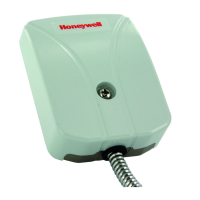
